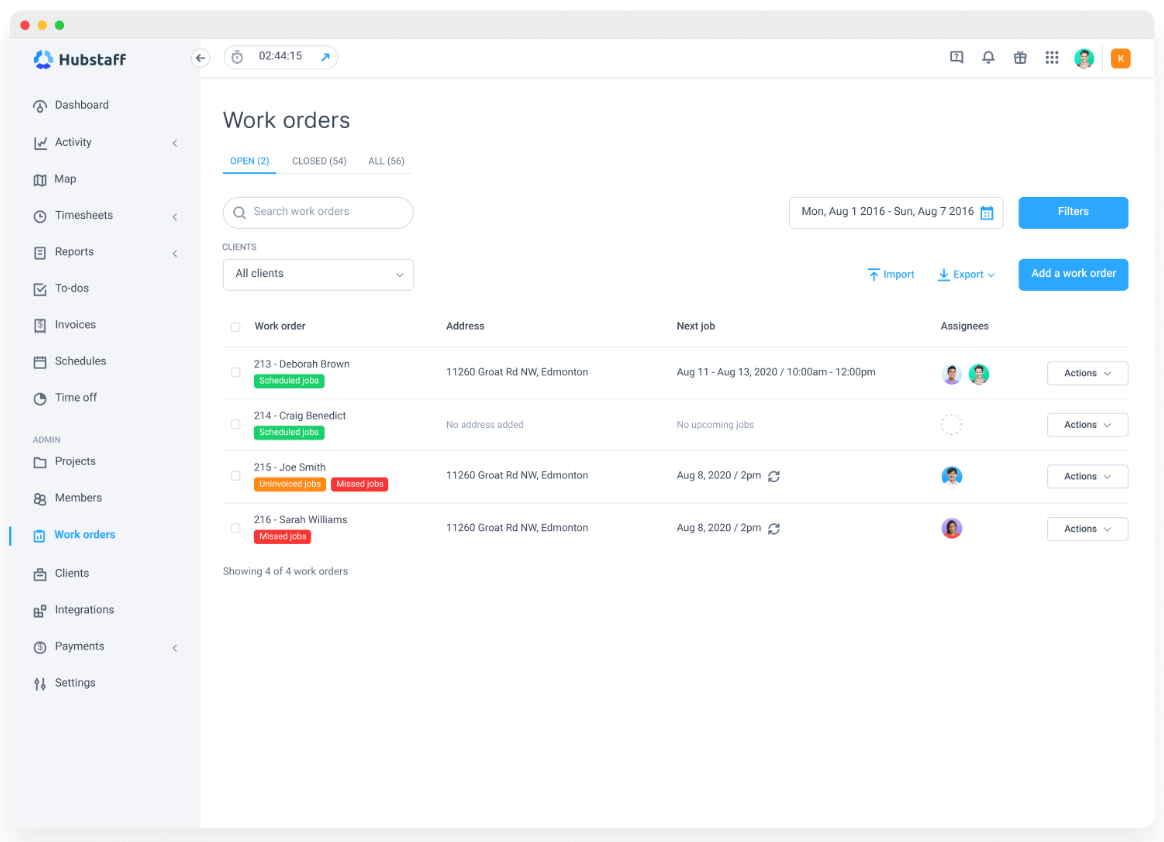Work orders are essential. From quick fixes to long-term stability, they’re crucial to asset management and helping managers keep operations running smoothly.
- Work orders provide a roadmap for a company’s maintenance team, helping everyone involved assign and prioritize essential tasks.
- Giving teams the ability to track jobs ensures everyone can complete work quickly and that operational efficiency continues as usual.
However, work orders can pose various challenges. Each new piece of maintenance requires a new work request. These can quickly mount up, making it difficult for teams to stay on top of documents and prioritize tasks.
The solution? A work order management strategy – but it can be daunting to know where to begin. So, getting to grips with the critical aspects of work order management is essential if you want to give your operations a kickstart.
Boost your team’s efficiency with Hubstaff's productivity tools
What is a work order?
A work order outlines all the steps needed to undertake a given task. Companies often use them for maintenance issues, audit follow-ups, or safety inspections.
Let’s imagine that a call center sales team cannot make calls due to Wi-fi issues, threatening to bring operations to a halt. The manager raises a service request form and quickly sends a work order to the maintenance manager.
The work order states what needs to be done, and thanks to this, asset downtime is minimized. Instead of constantly checking in for information and guidance, maintenance teams have all the information they need.
Beyond setting out requirements, work orders provide additional information for field workers, including details about who was assigned a job, the proposed completion date, and general expectations.
4 types of work orders
There isn’t one single template for work orders. Maintenance requests can significantly vary, so the required documentation will differ, too, depending on the work carried out.
Below are some broad categories that work orders can fall into:
- Equipment maintenance: This applies to corrective maintenance work orders to fix a faulty or inefficient piece of equipment or larger systems.
- Equipment inspections: Preventative maintenance tasks might involve routinely checking systems to ensure they are running as they should be. This form of work order is used most commonly in highly regulated industries.
- Safety inspection: Safety is an essential factor in maintenance scheduling. Hazards could range from chemical spills to tripping hazards. Safety work orders minimize these risks.
- Reactive maintenance: This applies to unplanned maintenance work to resolve problems with company assets.
Importance of work order management
Every new maintenance task requires a new work order. Not only that, but each team involved in maintenance needs one. Maintenance managers and teams can quickly become overwhelmed by the demand without a proper system. You’ll lose track of maintenance progress, and projects can soon fall behind schedule.
The right strategy can bring several benefits. Perhaps the most significant advantage is that you’ll have greater control over your work orders. You can better understand the equipment and parts needed for each job, track maintenance processes more efficiently, and analyze maintenance histories to identify common issues.
This can help you significantly streamline maintenance workflows to ensure teams remain productive and everyone can achieve their goals.
Work order management best practices
So, where should your work order management strategy begin? We’ve compiled some of the best procedures for keeping on top of work orders.
1. Choose the right work order management system
A successful management process is all about organization and optimization. For medium- to large-scale organizations, manual maintenance management can be impractical. With the scale of work orders needed, things can quickly descend into chaos as your team becomes overloaded with requests.
Investing in work order management software can pay dividends – and is a great starting point for creating an efficient work order management process.
The system provides critical data from a centralized platform, giving you real-time insights into your maintenance activities. You can easily track teams and ensure maintenance operations are running on schedule.

Other management system features to look for include:
- Maintenance planner: Create a maintenance schedule by assigning jobs based on the availability and capacity of staff.
- Time tracking: Track teams’ progress and see how long it takes to complete different tasks. Time tracking can reduce downtime and boost efficiency.
- Geo maps: Some systems enable access to interactive geo maps. You can easily track remote maintenance teams and field technicians across different locations.
- Improved communication: Clear information about employee tasks assists communication in your business. Use alongside work phone apps, which enable the quick exchange of messages for workers ‘on the go’. This will give greater clarity and understanding of the activity.
2. Assign responsibilities
Assigning jobs for each stage of the work order process is essential to stay streamlined. Who is responsible for creating new work orders? Whose job is it to post them? Who should review orders when projects are complete? A set of clearly assigned tasks allows more transparent communication and ensures more efficient work order management.
3. Decide on frequency
How often will maintenance tasks take place? This is an essential consideration for your work order management schedule. Conduct maintenance tasks too often, and you can prevent employees from doing their work.
On the flip side, too little maintenance can also cause disruption as systems might fall into disrepair. To help determine your maintenance frequency, refer to manufacturer guidelines for each piece of equipment. You can help prevent future breakdowns by conducting preventative maintenance promptly.
4. Provide access to maintenance resources
Lack of resources can be a millstone around the neck of maintenance teams. Let’s imagine urgent work is needed but progress comes to a halt because teams don’t have the right tools. Or, perhaps they run out of a specific material before they can finish the job.

When compiling work orders, list all the required tools and equipment. In addition, include documentation and instructions so maintenance personnel understand what’s needed to fix the faulty equipment. Maintenance staff will work with various devices daily, so providing them with resources to help jog their memory is highly beneficial.
For maintenance crews conducting work remotely, ensure they can access remote support software, such as RealVNC. This ensures teams can view learning materials easily, even while on the job.
5. Simplify request forms
Teams must work quickly when you have a high volume of maintenance work. Lengthy, complicated forms only slow the process and increase the likelihood of mistakes. Save time by simplifying forms into more streamlined documents.
Begin by customizing forms for each maintenance task. Focus on sections that are only relevant to that particular project.
6. Prioritize tasks
It’s essential to use priority levels in your work order management process. Which projects need the most urgent attention? Which tasks are part of predictive maintenance and can they be put on the back burner?
Without a clear focus, the most critical maintenance tasks won’t be completed on time. These delays can grind your organization to a halt.
The process of prioritization is split into three steps. Follow the procedure below to list work orders by priority level:
- Identify: What maintenance tasks are needed?
- Assess: How urgently does a task need to be completed? Does an issue:
- Pose a health risk?
- Impact daily operations?
- Cause costly downtime?
- Pose issues for customers?
- Allocate: What resources are needed for effective maintenance?
7. Measure performance
Most businesses understand the need to keep a close eye on sales engagement. But many don’t apply the same rigour to work orders. It’s crucial to know that these are completed and done to a high standard. That’s why it’s useful to have a method for measuring the success of maintenance projects.
Of course, measuring performance requires a constant flow of data. So it’s essential to ensure your ingestion process is streamlined. This way, you know you have access to the most up-to-date data and can monitor metrics more effectively.
There are three simple steps you can take to measure work orders:
- Identify goals for maintenance.
- Decide on a set of key performance indicators (KPIs) that align with your goals.
- Choose metrics to help measure progress toward your objectives.

8. Track the entire process
A key part of work order management is keeping track of different requests. But simply knowing which maintenance orders are in motion isn’t enough. You must carefully monitor them from creation until completion.
Your maintenance department must be integrated with other parts of the business, so make sure there is regular dialogue between maintenance managers, field techs, and any other teams involved.
An enterprise cloud-based phone system is ideal for larger organizations, as this ensures smooth communication regardless of employee location. It’s also beneficial for maintenance managers of global teams to track processes among different workforces.
Alongside this, it’s also essential to track resources as projects progress. Using an analytics dashboard is critical. Are certain materials being consumed faster than expected? Does a task require more significant staffing than anticipated? This information can be used to improve future maintenance projects.
Kickstart your work order management
If you want to achieve the optimal outcome for any piece of work, it’s clear that work orders are fundamental. But despite their importance, many organizations fail to optimize the process, leading to delayed projects and critical maintenance being overlooked. These problems can all be avoided with proper work order management.
In this guide, we’ve explored vital steps that you should undertake. These include careful system selection, having clarity on priority, frequency, and responsibilities, and simplifying your processes.
Don’t forget that you must also track progress and measure outcomes if you want long-term success.
So, take some time to reflect on the steps we’ve explored and see how you can enhance your work order management strategy.
About the author

Jenna Bunnell is the Director for Field and Strategic Events at Dialpad, an AI-incorporated cloud-hosted unified communications system that provides valuable call details for business owners and sales representatives. She is driven and passionate about communicating a brand’s design sensibility and visualizing how content can be presented in creative and comprehensive ways.
Most popular
The Critical Role of Employee Monitoring and Workplace Security
Why do we need employee monitoring and workplace security? Companies had to adapt fast when the world shifted to remote work...
15 Ways to Use AI in the Workforce
Whether through AI-powered project management, strategic planning, or simply automating simple admin work, we’ve seen a dramatic...
The AI Productivity Panel: Lessons From Leaders on What’s Working (and What’s Not)
When I moderated this AI productivity panel, I expected a solid conversation. What I didn’t expect was the flood of real-world i...
Employee Performance Dashboards: Templates, Tools, and Best Practices
Keeping track of how your team’s really doing can be tricky. Spreadsheets pile up, one-on-ones only tell part of the story, and...




